The state of Arkansas is full of natural beauty and is a wonderful outdoor vacation destination. The gorgeous landscapes of the Ozark highlands and the Ouachita Mountains alone are enough to inspire any outdoor lover. But as any outdoor expert will tell you, all that natural beauty is home to some dangers. Arkansas has six venomous snakes and three of them are rattlesnakes! Which snakes are the largest (and most dangerous) snakes in Arkansas? Which species is number one? Let us get into this list and find out!
The largest and most dangerous snakes found in Arkansas are the western pygmy rattlesnake, the western diamondback, the timber rattlesnake, the Texas coral, the copperhead, and the cottonmouth. To find out which species takes the top spot, we must start small and work our way up. However, size is not everything. The most dangerous snake in the state might not be the biggest, but in the United States, they are the deadliest!
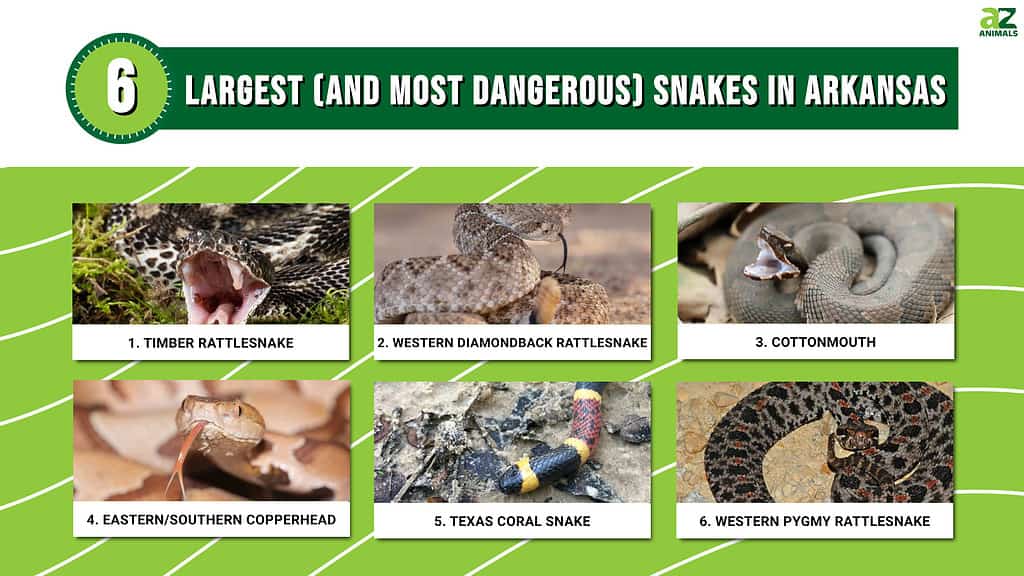
Honorable Mention: The Western Pygmy Rattlesnake
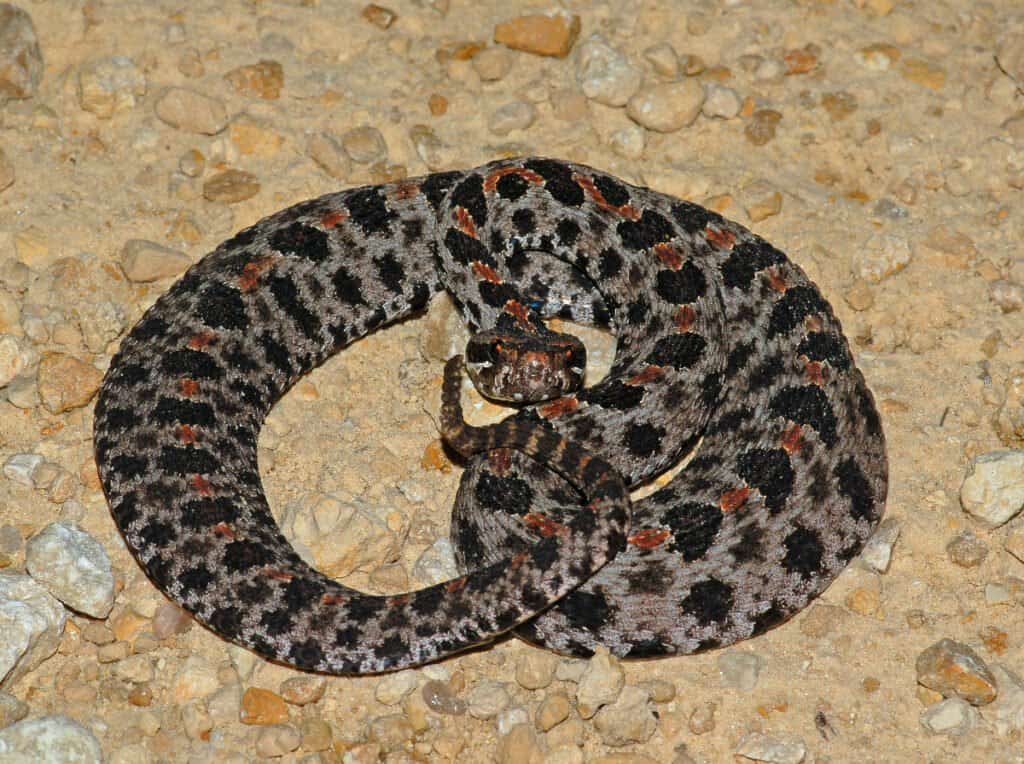
Though the Western pygmy rattlesnake isn’t the largest or most dangerous venomous snake in Arkansas, they get an honorable mention from us as number six!
©Gerald A. DeBoer/Shutterstock.com
| Size | 15-20 inches long |
| Habitat | Near large rivers and lakes |
| Threat | Venomous, the bite is not deadly but serious illness/injury occurs if untreated |
| Behavior | Reclusive and solitary, most bites occur through accidental contact |
Western pygmy rattlesnakes can be identified by their slate grey coloring, black crossband markings, and the reddish stripe down the back. They have lean, muscled bodies and narrow spear-tip-shaped heads and are the smallest of the rattlesnake species.
While this species is the smallest of Arkansas venomous snakes, its bite is still capable of costing a limb without medical intervention! This snake species can be found in all parts of the state except for its far eastern border.
Texas Coral Snake
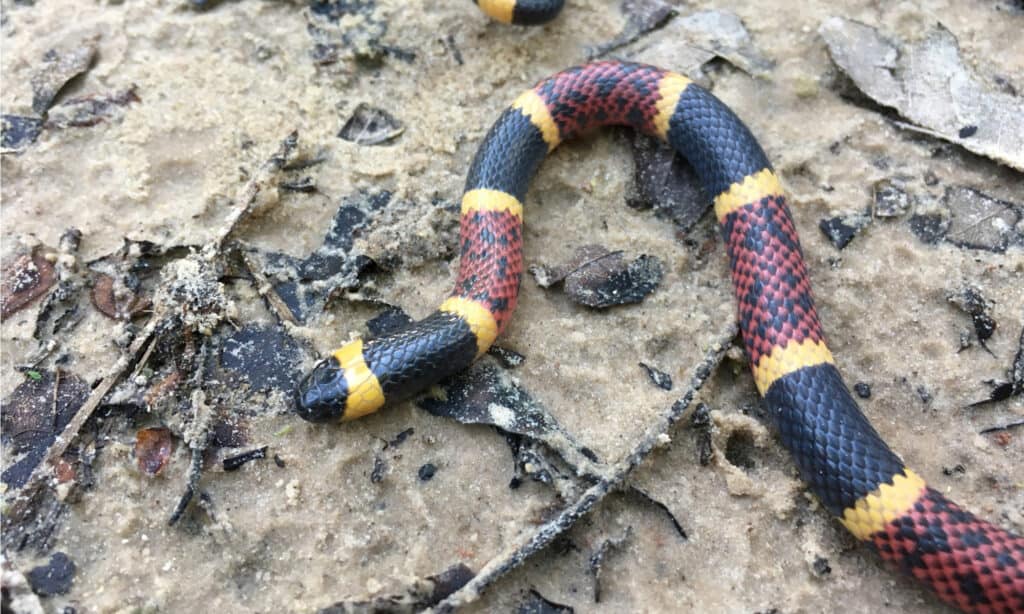
The Texas coral snake is notable for its bands of black, yellow, and red. In Arkansas, the Texas coral is only the fifth largest venomous snake, but due to its highly venomous bite, it is one of the most deadly!
©Joe Farah/Shutterstock.com
| Size | 12-24 inches long |
| Habitat | Lakes, rivers, large bodies of water |
| Threat | Highly venomous bite that is the second most deadly worldwide |
| Behavior | Moderately aggressive, but most bites occur through accidental contact |
Texas coral snakes can be identified by their overall red and black stripes, as well as their distinct yellow banding between each color. Like many other species of water-loving snakes, they have thin, long bodies and small heads. Coral snakes are often confused with non-venomous snakes, which have similar overall colors and markings. To tell them apart, remember, “Red touch black, venom lack. Red touch yellow, kill a fellow.”
In Arkansas, the Texas coral snake is found primarily in the Ouachita River and the southern region of the Little Mississippi River. While smaller than other snakes on this list, they can be far more deadly. However, with prompt medical attention, antivenom treatment is highly effective. Because of this, Arkansas has not had a bite-related death caused by this species since the 1960s!
Eastern/Southern Copperhead

Eastern/Southern copperheads are the fourth largest and most dangerous venomous snake in Arkansas.
©Dennis W Donohue/Shutterstock.com
| Size | 24-36 inches long |
| Habitat | Rocky areas, high elevations, hardwood forests, marshes |
| Threat | Venomous bite is extremely painful and can cause serious illness/loss of limb |
| Behavior | Moderately aggressive, strikes with no warning, blends well with surroundings. |
Copperheads can be identified by their overall reddish-brown coloring and brown hourglass markings. This species has a triangular head and slitted pupils like many other pit vipers. Copperheads are nocturnal but are more active during the day in the fall and spring. While most bites occur through accidental contact, they are aggressive when disturbed.
In Arkansas, the copperhead species can be found throughout the state. While considered to be one of the more aggressive snake species, they tend to avoid human dwellings. However, copperheads bite more people on average than any other United States snake.
Cottonmouth
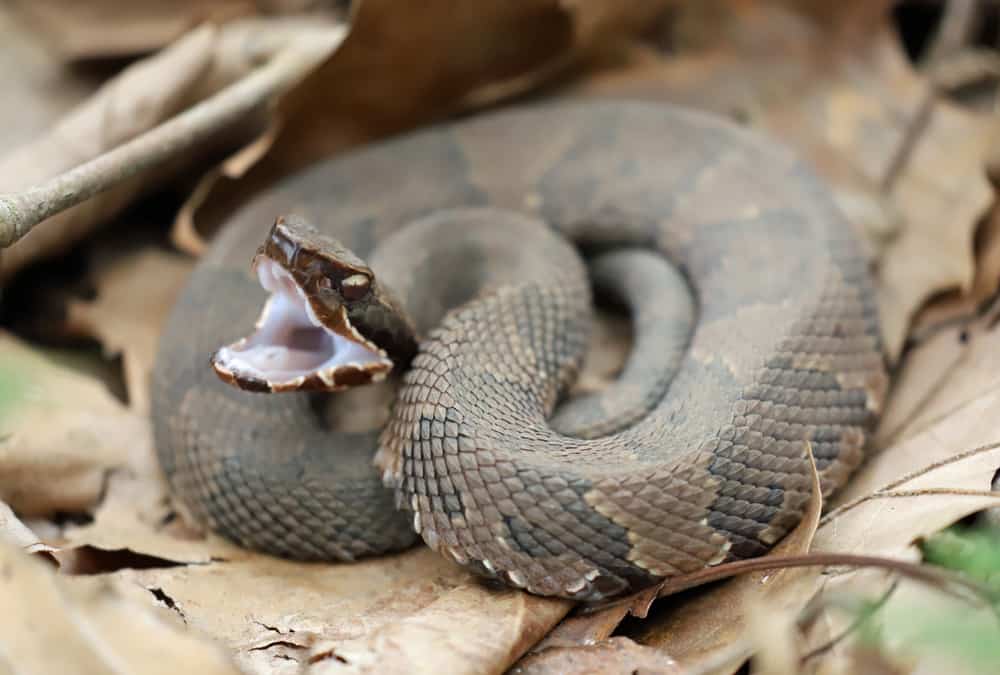
The cottonmouth is the third largest venomous snake found in Arkansas and can be identified by its distinctive white inner mouth, which it displays before striking.
©KF2017/Shutterstock.com
| Size | 20-48 inches long |
| Habitat | Swamps, marshlands, areas with standing water |
| Threat | Venom is deadly without medical attention |
| Behavior | Moderately aggressive, tilts head and opens mouth to display the white “cotton colored” interior in a warning. |
Cottonmouths are a reddish-brown color with black banded markings that darken to grey or black when mature. It has a spade-shaped head that distinguishes them from non-venomous water moccasins. While cottonmouths are not considered overly aggressive, most bites happen by accident when humans encounter them in water. Don’t be fooled by this snake’s reclusive nature though, a cottonmouth in Florida once took on an alligator!
In Arkansas, the cottonmouth can be found everywhere, but are less common near the Ozark highlands or the Ouachita mountains.
Western Diamondback Rattlesnake

The Western Diamondback rattlesnake is the largest venomous snake in Arkansas, but while it’s bite can be deadly, it is not the most dangerous!
©Alexander Wong/Shutterstock.com
| Size | 48 to 60 inches |
| Habitat | Coastal plains, hillsides, rocky outcrops |
| Threat | Highly venomous, dangerous if left untreated |
| Behavior | Aggressive, readily strikes if disturbed |
Western Diamondbacks are identified by their brown/tan/fawn coloring and distinctive deep brown/black diamond markings. They have thick, muscular bodies and large, spade-shaped heads with dark diagonal stripes below the eyes. The largest western diamondback ever recorded was seven feet long!
This species is the rarest venomous snake spotted in Arkansas and is primarily found in the Ouachita Mountain region and the southwestern regions of the Ozark highlands.
Timber Rattlesnake
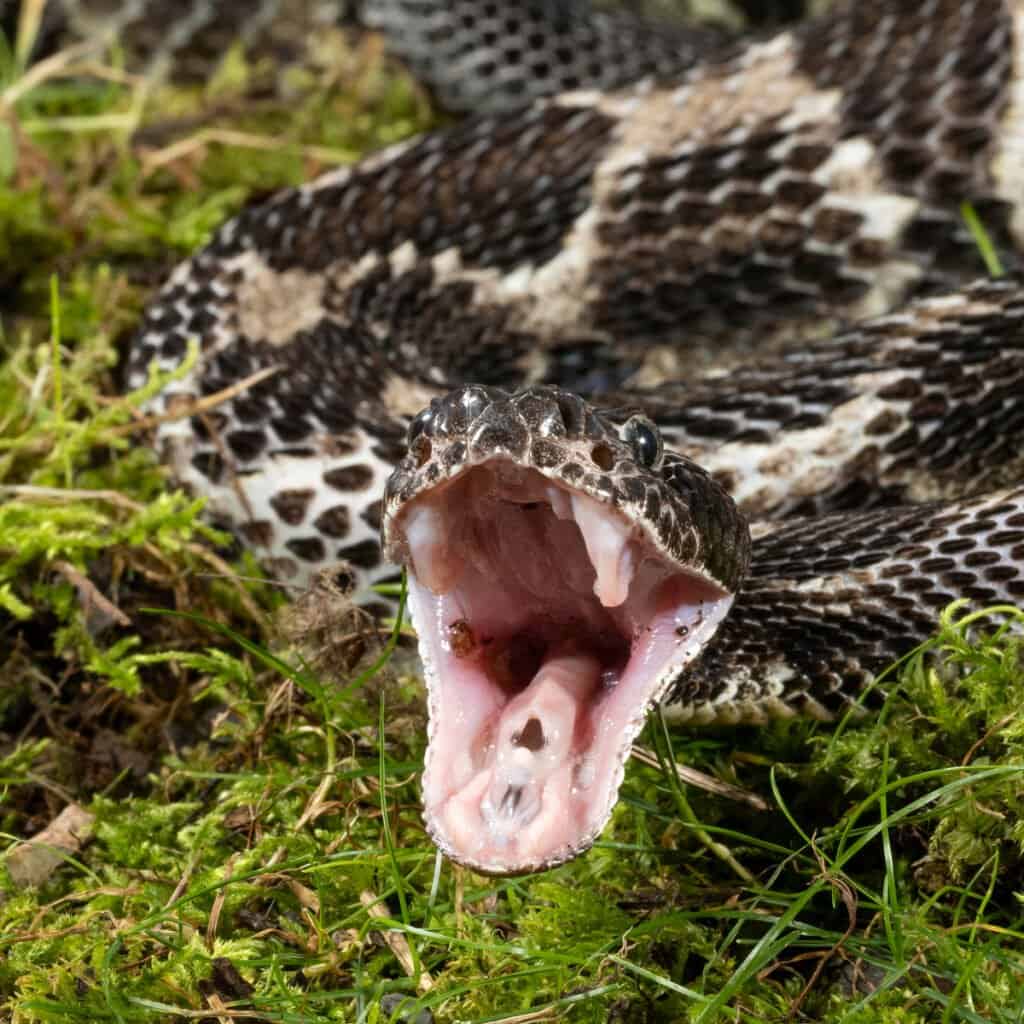
Timber Rattlesnakes are not only the most dangerous snake found in Arkansas, but they also have the highest venom concentration of any other U.S snake!
©Joe McDonald/Shutterstock.com
| Size | 36-60 inches long |
| Habitat | Forests, farms, agricultural areas, lowlands |
| Threat | Venomous, deadly without prompt medical attention |
| Behavior | Ambush hunter with a little warning prior to striking. |
The largest and most dangerous snake in Arkansas is the timber rattlesnake. Timber rattlesnakes are a yellowish-grey color overall, with brown to black arrow-shaped markings and a reddish-brown vertical stripe on the back. Like many rattlesnakes, the timber species prefers areas with little human contact. However, they are also known to give far less warning prior to striking than other rattlesnakes. While a slow retreat is recommended for other species, most experts advise you to get away from Timber rattlers quickly.
The timber rattlesnake is not only the deadliest in Arkansas, but it also has the highest venom concentration of any U.S. snake! The species is found all over the state and is most active between April to October. Though rattlers prefer to avoid human locations, a Texas family once came home to find a timber rattlesnake sitting on their couch!
Summary of The Top 6 Largest (And Most Dangerous) Snakes In Arkansas
Here’s a quick look at the top largest and most dangerous snakes in Arkansas this summer:
| Rank | Snake | Size | Threat |
|---|---|---|---|
| 1. | Timber Rattlesnake | 36-60 inches | Venomous, deadly without prompt medical attention |
| 2. | Western Diamondback Rattlesnake | 48-60 inches | Highly venomous, dangerous if left untreated |
| 3. | Cottonmouth | 20-48 inches | Venom is deadly without medical attention |
| 4. | Eastern/Southern Copperhead | 24-36 inches | Venomous bite is extremely painful and can cause serious illness/loss of limb |
| 5. | Texas Coral Snake | 12-24 inches | Highly venomous bite that is the second most deadly worldwide |
| 6. | Western Pygmy Rattlesnake | 15-20 inches | Venomous, the bite is not deadly but serious illness/injury occurs if untreated |
The photo featured at the top of this post is © Scott Delony/Shutterstock.com
Discover the "Monster" Snake 5X Bigger than an Anaconda
Every day A-Z Animals sends out some of the most incredible facts in the world from our free newsletter. Want to discover the 10 most beautiful snakes in the world, a "snake island" where you're never more than 3 feet from danger, or a "monster" snake 5X larger than an anaconda? Then sign up right now and you'll start receiving our daily newsletter absolutely free.
Thank you for reading! Have some feedback for us? Contact the AZ Animals editorial team.






